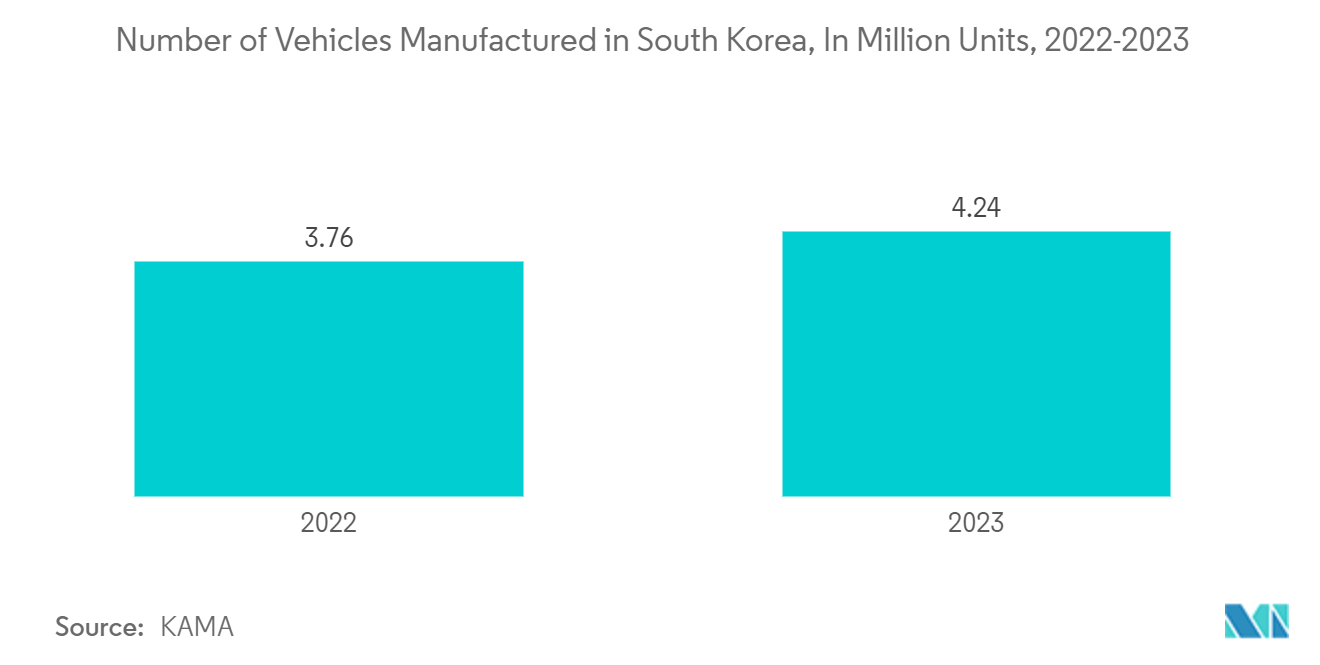Market Trends of South Korea Discrete Semiconductors Industry
Automotive is Expected to Witness a Significant Growth
- Automotive demands fuel the market for discrete components, particularly power transistors and rectifiers. While traditional vehicles have relied on 12-V battery systems for decades, they are now struggling to support the increased electronic demands of modern cars, highlighting the necessity for more energy-efficient solutions. In modern electric vehicles, the demand for discrete semiconductors is growing as these are used for power distribution and transmission. While traditional gasoline automobiles rely on efficient electrical component usage, discrete semiconductors notably boost performance.
- South Korea has emerged as a critical player in the global automotive sector, solidifying its position on the world stage in the past few years. The automotive industry and South Korea's semiconductor sector are a linchpin in the nation's export expansion and economic progress. Following integrated circuits, automobiles represent the second-largest export segment. According to Invest Korea, in 2023, vehicle exports were valued at USD 70.9 billion. This marked a 30% increase from the previous record, driven mainly by the export of high-value eco-friendly cars.
- With South Korea's transition to EVs, car companies building SiC-based inverter prototypes have rapidly increased in the past few years, driving the growth of the market. In the sector, the primary applications for SiC power MOSFETs, diodes, and modules are onboard electric vehicle (EV) chargers, DC/DC converters, and drivetrain inverters. Plug-in hybrid EVs and BEVs use onboard chargers to refuel the vehicle battery at home or a public charging station.
- For instance, in 2023, South Korea was set to overhaul its EV subsidy policy, prioritizing local manufacturers that excel in performance, infrastructure, battery density, and pricing. This move is poised to notably advantage Hyundai and Kia. The subsidies are set to vary, spanning from KRW 2.5 million to KRW 6.8 million (equivalent to USD 1,867 to USD 5,078), with vehicles priced over KRW 85 million (USD 63,481) being excluded from the subsidy bracket.

Power Transistors is Expected to Hold Significant Market Share
- A silicon (Si) MOSFET is a discrete semiconductor device commonly used in electronic circuits for amplifying or switching electronic signals. The voltage to the gate determines the device's conductivity, allowing it to change conductivity with the amount of applied voltage. MOSFET power transistors are crucial in efficiently functioning electric vehicles (EVs). They are employed in motor drive systems, battery management systems, DC-DC converters for auxiliary systems, etc. The robust growth of EVs in South Korea will likely drive the development of the market.
- For instance, in June 2024, Infineon Technologies AG is broadening its range of next-gen OptiMOS 7 MOSFETs tailored for automotive applications. The 40 V lineup now features new additions in durable, lead-free packages. Moreover, the SSO8 package now accommodates the 80 V and 100 V OptiMOS 7 MOSFETs. The MOSFETs have been designed to suit current and anticipated automotive applications at 48 volts. These applications encompass electric power steering, braking systems, power switches, and battery management.
- Owing to the various benefits associated with incorporating SiC in MOSFETs, the market is observing a significant number of product launches, driving the growth of the market studied. For instance, in February 2024, SemiQ added to its silicon carbide N-channel MOSFET portfolio with full-wave H-bridge modules. As per the company, the parts are intended for triple-threat applications requiring high-voltage, high-speed, and high-power parts. The high efficiency, high junction temperature tolerance, and ceramic packaging are claimed to reduce heat sinking and increase mechanical placement flexibility.
- The increasing demand for consumer electronic appliances like air conditioners, power conditioners, etc., which use discrete IGBT types for lower-current applications, is credited with driving the growth of the discrete IGBT market. Discrete IGBTs have been found to have the lowest power losses in consumer goods, which is anticipated to be a key factor influencing the growth of the segment in the market.
- For instance, in February 2024, Vishay Intertechnology introduced a line of IGBT power modules housed in a revamped INT-A-PAK package. These half-bridge devices, leveraging trench IGBT technology, provide the flexibility of opting for either low VCE(ON) or low Eoff, catering specifically to high-current inverter stages. The company's release includes a total of five of these upgraded modules.


